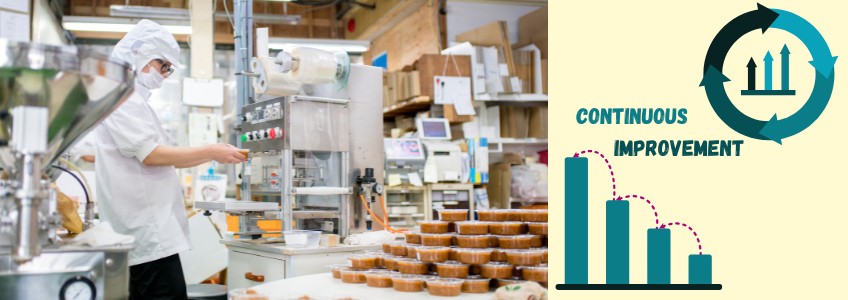
Introduction
Today’s packaged food industry is very dynamic. It is a market place where consumer demands are constantly evolving and competition is fierce, businesses must continuously adapt and improve. This necessitates a culture of continuous improvement that permeates every level of the organization.
While various strategies and methodologies contribute to this goal, effective leadership is the cornerstone. This blog post will explore the critical role of leadership in driving continuous improvement within the packaged food industry, highlighting key factors for success and potential roadblocks.
The Leadership Imperative
Leaders in the packaged food industry have a unique responsibility to cultivate a culture that embraces continuous improvement. Their actions, decisions, and communication directly influence how teams approach challenges, adapt to change, and innovate.
Leaders empower employees at all levels, by championing continuous improvement, to actively participate in identifying areas for enhancement. They can also motivate the employees to propose solutions, and drive meaningful change within the organization.
Key Factors for Success
There are several critical factors that contribute to the successful implementation of continuous improvement initiatives within the packaged food industry.

1. Establishing a Clear Vision and Objectives
- A clear and shared vision for continuous improvement is paramount. Leaders must articulate the “why” behind improvement efforts, outlining the desired outcomes and how they align with the overall business strategy.
- Setting specific, measurable, achievable, relevant, and time-bound (SMART) objectives provides a clear roadmap for teams and helps track progress effectively.
2. Investing in Training and Skill Development
- Continuous improvement requires a skilled workforce. Leaders must invest in training programs that equip employees with the necessary knowledge and tools for effective problem-solving.
- Methodologies like Lean, Six Sigma, and Design for Six Sigma provide valuable frameworks for identifying and eliminating waste, improving efficiency, and enhancing product quality.
3. Fostering a Culture of Innovation
- Leaders must create an environment that encourages experimentation, risk-taking, and creative problem-solving.
- Recognizing and rewarding innovative ideas, providing resources for experimentation, and celebrating successes are crucial for fostering a culture of innovation.
4. Overcoming Resistance to Change
- Change can be challenging, and resistance is often inevitable. Leaders must proactively address concerns and communicate the benefits of change effectively.
- They should create a safe environment where employees feel comfortable sharing their perspectives and concerns.
5. Prioritizing Effective Communication
- Open and transparent communication is vital for successful continuous improvement. Leaders must ensure that information flows freely across all levels of the organization.
- Regular feedback, sharing best practices, and celebrating successes help to keep teams motivated and aligned towards common goals.
Potential Roadblocks
Despite the best intentions, several factors can hinder the success of continuous improvement initiatives:
- Lack of Leadership Commitment: Without consistent support and active involvement from leadership, continuous improvement efforts can easily lose momentum.
- Insufficient Employee Engagement: If employees do not feel empowered to contribute or see the value of improvement initiatives, their participation will be limited.
- Lack of Resources and Support: Inadequate resources, such as time, budget, and technology, can significantly hamper progress.
- Focus on Short-term Gains Over Long-term Sustainability: An excessive focus on short-term gains can undermine the long-term sustainability of continuous improvement efforts.
Conclusion
In the competitive landscape of the packaged food industry, continuous improvement is not an option, but a necessity for long-term success. Leaders can drive significant improvements in efficiency, quality, and customer satisfaction. This can be done by fostering a culture that embraces change, empowers employees, and prioritizes innovation.
Therefore, by addressing the key factors outlined in this blog post and overcoming potential roadblocks, packaged food companies can unlock their full potential and thrive in a dynamic and ever-evolving market.
If you are interested to achieve similar success stories, write to us!
